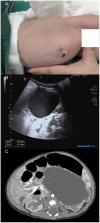Da Vinci robotic assisted pyeloplasty versus laparoscopic pyeloplasty in newborns under 3 months
- PMID: 40760161
- PMCID: PMC12322090
- DOI: 10.1038/s41598-025-14603-x
Da Vinci robotic assisted pyeloplasty versus laparoscopic pyeloplasty in newborns under 3 months
Abstract
Ureteropelvic junction obstruction (UPJO) is a common cause of hydronephrosis in children. We aimed to investigate the efficacy of robotic-assisted laparoscopic pyeloplasty (RALP) in newborns with UPJO compared to laparoscopic pyeloplasty (LP). We conducted a retrospective study of newborns aged ≤ 3 months who underwent RALP or LP from May 2018 to December 2023. Only primary pyeloplasty cases were included. Seventy-seven newborns (RALP = 46; LP = 31) were enrolled and no significant difference in the newborns' demographics and pre-operative parameters was found. The mean operation time (OT) was 161.30 ± 29.07 min (RALP) and 200.60 ± 26.66 min (LP) (P < 0.0001), and the mean hospitalization stay was 7.80 ± 1.13 days (RALP) and 9.32 ± 1.19 days (LP) (P < 0.0001). RALP was associated with a higher hospitalization cost than LP (73449 ± 8513 yuan vs. 40152 ± 7555 yuan; P < 0.0001). The effectiveness and safety of RALP for treating UPJO in newborns is comparable to that of LP. In addition, RALP might have advantages over LP with its faster recovery and less trauma.
Keywords: Laparoscopy; Newborn; Pyeloplasty; Retrospective study; Robot-assisted; Ureteropelvic junction obstruction.
© 2025. The Author(s).
Conflict of interest statement
Declarations. Competing interests: The authors declare no competing interests. Disclosure of potential conflicts of interest: The authors have no relevant financial or non-financial interests to disclose. Research involving human participants and/or animals: This study contains human participants. Informed consent: The guardian of the patient gave permission to use their clinical data in this paper and for the publication of this research. Ethical approval: The study was approved by the Ethics Committee of Henan Provincial People’s Hospital (No.: 2322122014).
Figures



Similar articles
-
Has robot-assisted pyeloplasty reached outcome parity with laparoscopic pyeloplasty in children <15 kg? A Paediatric YAU international multi-center study.J Pediatr Urol. 2024 Dec;20(6):1154-1159. doi: 10.1016/j.jpurol.2024.09.008. Epub 2024 Sep 14. J Pediatr Urol. 2024. PMID: 39307658
-
Comparison of the treatment effect of laparoscopic and robot-assisted single-port laparoscopic pyeloplasty on ureteropelvic junction obstruction in infants.J Robot Surg. 2025 Jul 6;19(1):353. doi: 10.1007/s11701-025-02528-6. J Robot Surg. 2025. PMID: 40618311
-
Comparative outcomes of robotic-assisted and conventional laparoscopic pyeloplasty in pediatric patients: a decade of evidence.J Robot Surg. 2025 Jul 30;19(1):436. doi: 10.1007/s11701-025-02618-5. J Robot Surg. 2025. PMID: 40736602
-
A systematic review and metaanalysis of open, conventional laparoscopic and robot-assisted laparoscopic techniques for re-do pyeloplasty for recurrent uretero pelvic junction obstruction in children.J Pediatr Urol. 2022 Oct;18(5):642-649. doi: 10.1016/j.jpurol.2022.08.025. Epub 2022 Sep 3. J Pediatr Urol. 2022. PMID: 36117037
-
Outcomes of robot-assisted laparoscopic pyeloplasty among pediatric patients with complex renal anatomy: A retrospective comparative study.J Pediatr Urol. 2024 Dec;20(6):1174-1178. doi: 10.1016/j.jpurol.2024.07.019. Epub 2024 Jul 25. J Pediatr Urol. 2024. PMID: 39174394
References
-
- Shu, Q. Robotic-assisted surgery in pediatrics: current applications, limitations and prospects. In Pediatric Robotic Surgery 1–5 (Springer Nature Singapore, 2023). 10.1007/978-981-19-9693-1_1.
-
- Esposito, C. et al. Robotics and future technical developments in pediatric urology. Semin Pediatr. Surg.30, 151082 (2021). - PubMed
-
- Costigan, C. S. & Rosenblum, N. D. Understanding ureteropelvic junction obstruction: how Far have we come? Frontiers Urology3, 1154740 (2023).
Publication types
MeSH terms
Grants and funding
LinkOut - more resources
Full Text Sources

